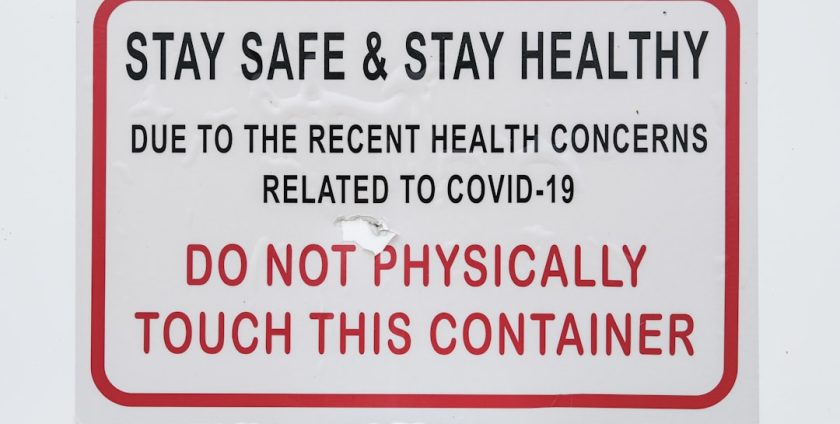
- By: admin
- Category: Commercial Floor Cleaning Machines
- 0 comment
Infection control is a critical component of healthcare, particularly in aged care facilities and hospitals where vulnerable populations reside. The elderly and those with pre-existing health conditions are at a heightened risk of infections, which can lead to severe complications or even fatalities. The World Health Organisation (WHO) has emphasised that effective infection prevention and control (IPC) measures are essential for safeguarding patients, staff, and visitors alike.
In these environments, the stakes are incredibly high; a single lapse in hygiene can result in outbreaks of healthcare-associated infections (HAIs), which not only compromise patient safety but also strain healthcare resources. Moreover, the financial implications of poor infection control cannot be overlooked. Hospitals and aged care facilities face significant costs associated with treating infections, including extended hospital stays, additional treatments, and potential legal liabilities.
By prioritising infection control, facilities can enhance patient outcomes, reduce costs, and foster a culture of safety and trust. This commitment to cleanliness and hygiene is not merely a regulatory requirement; it is a moral obligation to protect those who are most at risk. Please feel free to get in touch with us through our Contact Us page.
Summary
- Infection control is crucial in aged care and hospitals to protect vulnerable patients and prevent the spread of diseases.
- The floor plays a significant role in infection control as it can harbour harmful bacteria and viruses if not properly maintained.
- Poor floor maintenance can pose serious risks, including the spread of infections and slips and falls, especially in high-risk areas such as operating theatres and patient rooms.
- Best practices for floor cleaning and maintenance include using appropriate cleaning agents, equipment, and techniques to effectively remove contaminants and prevent the spread of infections.
- Choosing the right flooring materials, such as non-porous and easy-to-clean options, is essential for infection control in healthcare settings.
The Role of the Floor in Infection Control
The floor is often an overlooked aspect of infection control, yet it plays a pivotal role in maintaining a hygienic environment. In healthcare settings, floors can harbour pathogens that contribute to the spread of infections. Contaminants such as bacteria, viruses, and fungi can thrive on various flooring surfaces, making regular cleaning and maintenance essential.
For instance, studies have shown that certain pathogens can survive on floors for extended periods, posing a risk to patients and staff who may come into contact with these surfaces. In addition to being a reservoir for pathogens, floors can also facilitate the movement of contaminants throughout a facility. When staff or visitors walk across uncleaned surfaces, they can inadvertently transfer pathogens to other areas, exacerbating the risk of infection.
Therefore, understanding the role of flooring in infection control is crucial for building managers and facility operators. By implementing effective cleaning protocols specifically tailored to flooring materials, facilities can significantly reduce the risk of HAIs and create a safer environment for all.
Risks Associated with Poor Floor Maintenance

Neglecting floor maintenance can lead to a myriad of risks that extend beyond mere aesthetics. One of the most pressing concerns is the accumulation of dirt and debris, which can serve as a breeding ground for harmful microorganisms. In high-traffic areas such as corridors and waiting rooms, the risk is even greater as these spaces are frequented by numerous individuals daily.
For example, a study conducted in a hospital setting found that floors in patient rooms were often contaminated with Clostridium difficile spores, highlighting the urgent need for rigorous cleaning practices. Furthermore, poor floor maintenance can result in physical hazards that may lead to accidents and injuries. Slips, trips, and falls are common occurrences in healthcare environments, often exacerbated by unclean or damaged flooring.
Such incidents not only pose a risk to patients but also to staff members who may be navigating these spaces while attending to their duties. The repercussions of these accidents can be severe, leading to increased liability for the facility and potential harm to individuals involved.
Best Practices for Floor Cleaning and Maintenance
To mitigate the risks associated with poor floor maintenance, it is essential to adopt best practices for cleaning and upkeep. Regular cleaning schedules should be established, ensuring that high-traffic areas receive frequent attention. This includes daily cleaning of floors using appropriate disinfectants that are effective against a broad spectrum of pathogens.
For instance, using hospital-grade disinfectants can significantly reduce microbial load on surfaces. In addition to routine cleaning, deep cleaning should be performed periodically to address areas that may be overlooked during regular maintenance. This could involve stripping and sealing floors or using specialised equipment such as floor scrubbers to ensure thorough sanitisation.
Moreover, employing a colour-coded cleaning system can help prevent cross-contamination between different areas of the facility. For example, using specific mops and cloths for bathrooms versus patient rooms can minimise the risk of spreading pathogens.
Choosing the Right Flooring Materials for Infection Control
Selecting appropriate flooring materials is another critical aspect of infection control in healthcare settings. Certain materials are more conducive to maintaining hygiene than others. For instance, non-porous surfaces such as vinyl or linoleum are easier to clean and less likely to harbour bacteria compared to porous materials like carpet.
In environments where infection control is paramount, opting for flooring that is resistant to stains and easy to disinfect can make a significant difference. Additionally, flooring materials should be chosen based on their durability and slip-resistance properties. In high-traffic areas, it is vital to select materials that can withstand heavy use while providing safety for both patients and staff.
For example, rubber flooring offers excellent slip resistance and is easy to maintain, making it an ideal choice for hospitals and aged care facilities. By investing in the right flooring materials, facilities can enhance their infection control efforts while ensuring a safe environment for all occupants.
Implementing Effective Cleaning Protocols

Implementing effective cleaning protocols is essential for maintaining high standards of hygiene in healthcare settings. These protocols should be based on evidence-based practices that take into account the specific needs of the facility. For instance, developing standard operating procedures (SOPs) for floor cleaning can help ensure consistency among staff members while minimising the risk of errors.
Moreover, it is crucial to incorporate feedback mechanisms into cleaning protocols. Regular audits and inspections can help identify areas for improvement and ensure that cleaning practices are being followed correctly. Facilities may also consider utilising technology such as automated cleaning systems or monitoring software to enhance efficiency and effectiveness in their cleaning operations.
Training and Education for Staff
Training and education play a vital role in ensuring that staff members are equipped with the knowledge and skills necessary for effective infection control. Comprehensive training programmes should cover topics such as proper cleaning techniques, the importance of personal protective equipment (PPE), and the significance of adhering to established protocols. By fostering a culture of continuous learning, facilities can empower their staff to take ownership of infection control efforts.
Additionally, ongoing education should be provided to keep staff updated on the latest developments in infection prevention strategies. This could include workshops or seminars led by infection control experts who can share insights on emerging pathogens or innovative cleaning technologies. By investing in staff training, facilities not only enhance their infection control measures but also promote a sense of professionalism and accountability among their workforce.
The Impact of Clean Floors on Overall Infection Control
The impact of clean floors on overall infection control cannot be overstated. A well-maintained floor contributes significantly to reducing the transmission of pathogens within healthcare environments. When floors are regularly cleaned and disinfected, the likelihood of HAIs decreases substantially, leading to improved patient outcomes and enhanced safety for staff members.
Furthermore, clean floors create a positive impression on patients and visitors alike. A facility that prioritises cleanliness demonstrates its commitment to providing high-quality care and fostering a safe environment. This not only enhances patient satisfaction but also builds trust within the community.
Ultimately, investing in effective floor cleaning practices is an investment in the health and well-being of all individuals who enter the facility. In conclusion, infection control in aged care facilities and hospitals is paramount for safeguarding vulnerable populations from harmful pathogens. The role of flooring in this equation is significant; maintaining clean floors through best practices and appropriate materials is essential for minimising risks associated with infections.
By implementing effective cleaning protocols and investing in staff training, facilities can create an environment that prioritises safety and hygiene. **FAQs** 1. **Why is infection control particularly important in aged care facilities?**
Infection control is crucial in aged care facilities due to the vulnerability of residents who may have weakened immune systems or pre-existing health conditions.
2. **What types of flooring are best suited for infection control?**
Non-porous materials such as vinyl or linoleum are ideal as they are easier to clean and less likely to harbour bacteria compared to porous materials like carpet. 3.
**How often should floors be cleaned in healthcare settings?**
High-traffic areas should be cleaned daily using appropriate disinfectants, while deep cleaning should occur periodically based on facility needs. 4. **What training should staff receive regarding infection control?**
Staff should receive comprehensive training on proper cleaning techniques, the use of personal protective equipment (PPE), and adherence to established cleaning protocols.
5. **How does clean flooring impact patient satisfaction?**
Clean floors contribute to a positive impression of the facility, demonstrating a commitment to hygiene and safety which enhances overall patient satisfaction and trust.
FAQs
What is infection control in aged care and hospitals?
Infection control in aged care and hospitals refers to the measures and protocols put in place to prevent the spread of infections among residents, patients, and healthcare workers. This includes practices such as hand hygiene, cleaning and disinfection, and the use of personal protective equipment.
Why is the floor important in infection control?
The floor is an important aspect of infection control as it can harbor harmful pathogens and bacteria that can contribute to the spread of infections. Contaminated floors can transfer pathogens to other surfaces and be a source of infection for residents, patients, and healthcare workers.
How can the floor contribute to the spread of infections in aged care and hospitals?
Contaminated floors can contribute to the spread of infections in aged care and hospitals by serving as a reservoir for pathogens. When people walk on the contaminated floor, they can pick up the pathogens on their shoes and transfer them to other areas, increasing the risk of infection.
What measures can be taken to control infections related to the floor in aged care and hospitals?
Measures to control infections related to the floor in aged care and hospitals include regular cleaning and disinfection of floors, using appropriate cleaning agents and techniques, implementing protocols for shoe and equipment hygiene, and promoting the use of clean footwear in healthcare settings.
How can healthcare facilities ensure proper infection control related to the floor?
Healthcare facilities can ensure proper infection control related to the floor by implementing comprehensive cleaning protocols, providing staff with training on infection control practices, using effective cleaning products and equipment, and regularly monitoring and auditing the cleanliness of the facility’s floors.
